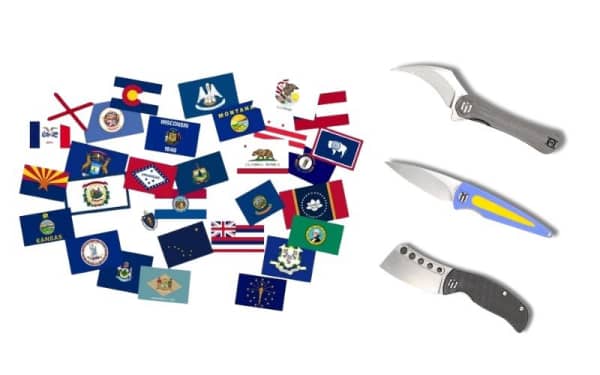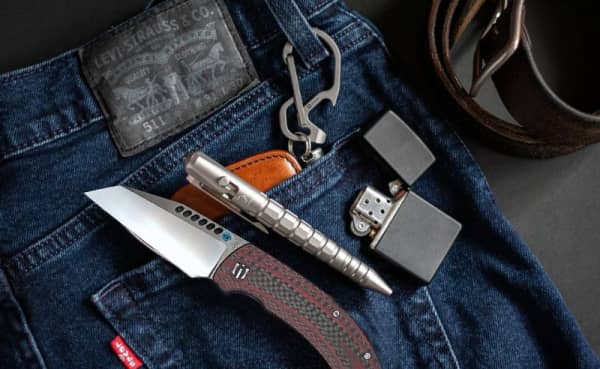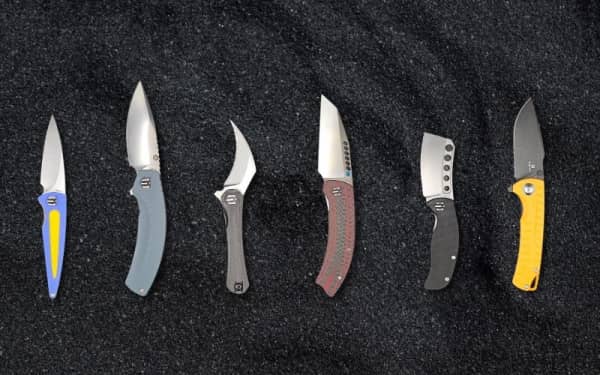In the United States, carrying a pocket knife is not only a tool but often an essential component of outdoor activities such as camping and fishing. It serves a variety of purposes, from utility to self-defense.
However, knife laws vary significantly from state to state, making it critical for individuals to familiarize themselves with the laws in their area.
This guide aims to provide a comprehensive overview of the different knife laws in every U.S. state to ensure you stay within the confines of the law while exercising your rights.
Federal Framework for Knife Laws
Understanding the Federal Law on Pocket Knives
In the big picture of knife regulations in the United States, Federal Law focused on one type of knife – the switchblade. The Federal Switchblade Act, passed in 1958, was quite strict. It essentially said that you couldn’t own, sell, or even move around with switchblades across state borders. But don’t worry, things have changed a bit since then.
Several important changes and additions to this law have eased these tight restrictions. For instance, if you have a disability that necessitates the use of a switchblade, you are now exempt from these strict regulations.
The relationship between federal and state law
The relationship between federal and state law when it comes to knife regulations can be a bit complex. In a nutshell, federal laws set the baseline – the minimum restrictions that apply all across the country. State laws, on the other hand, can either align with the federal law or impose stricter rules.
So, while federal law might allow for the ownership of a certain type of knife, a state law might restrict it further. This is why it’s important to not only understand the federal laws but also be aware of the specific laws in your state. It’s always advisable to comply with the stricter rule when there’s a conflict between state and federal laws.
Federal Transportation Security Administration (TSA) Regulations
The Transportation Security Administration (TSA) has specific rules regarding knives, especially when it comes to air travel. According to the TSA, all knives, regardless of size or type, are not allowed in carry-on luggage. This includes pocket knives, multi-tools with knives, and even butter knives.
However, you can pack them in your checked luggage. It’s important to note that TSA rules override both state and federal laws. So, even if your pocket knife is legal in your state or under federal law, if you’re flying, you must follow the TSA rules.
If you forget to transfer your pocket knife to your checked baggage, it may be confiscated at the security checkpoint, regardless of local or federal laws.
Overview of Knife Laws in Each State
Summary of Laws by State
Knife regulations, often found within weapon-related statutes, can vary greatly from one state to another. Some may classify certain knives as weapons based on the type, blade length, or other specific features.
NOTE of the Exemptions: Various exemptions exist to the restrictions on carrying weapons, which can include knives. These exemptions often apply to individuals involved in certain professions like law enforcement, military, or government operations. Additionally, exceptions are made for certain activities such as hunting and fishing. What is considered concealed can also differ from state to state. It’s not within the scope of this overview to address all of these variations and exemptions.
If you think you might qualify for an exemption, please use the information provided here as a starting point for further research.
Restrictions: In many states, there are additional restrictions for individuals with prior criminal convictions. There are often laws that dictate where “weapons,” including knives, can and cannot be carried. Examples of these prohibited areas include schools, polling places, courthouses, government buildings, places where alcohol is served, airports, and nuclear power stations, among others. Identifying all of these locations and circumstances is beyond the scope of this overview.
It’s important to note that the penalties for carrying an illegal knife can vary greatly between states. In some states, it might be a minor misdemeanor, while in others, it could be a serious felony.
Tool Length Limit
Generally, in most U.S. states, no explicit restrictions dictate the blade length of a knife you can own. However, when it comes to carrying a knife in public, many states enforce rules limiting the maximum blade length allowed. These rules can differ dramatically across states and even within different public settings within the same state.
For example, in California, it’s legal to carry any knife with a blade length of less than 2 inches. However, if you’re in Texas, you can comfortably carry a knife with a blade length of up to 5.5 inches. Anything beyond these lengths could potentially result in penalties or fines, hence the importance of understanding the specific stipulations in your area.
Further complicating matters, certain public places like schools, government buildings, or airports may have stricter rules irrespective of the state’s general laws.
Open Carry vs. Concealed Carry Laws
In the context of knife laws, “open carry” refers to carrying a knife in a manner that’s visible to those around you. This could be on your belt, in a sheath on your leg, or any other place where it’s clearly visible.
On the other hand, “concealed carry” refers to carrying a knife in a way that is hidden from view. Typically, this includes carrying a knife in your pocket, in your boot, or in any other location where it’s not immediately visible to others.
When it comes to laws about open carry vs. concealed carry, the regulations can vary significantly across different U.S. states. Some states have more lenient laws regarding open carry, allowing you to carry larger knives or even certain types of knives that may be banned for concealed carry.
Conversely, some states have stricter rules regarding open carry compared to concealed carry, often with specific stipulations about knife types and lengths.
Generally, concealed carry laws tend to be stricter than open carry laws. The rationale behind this is the perceived threat that concealed weapons pose.
However, it’s crucial to note that the specifics can vary greatly from one jurisdiction to another, and it’s always recommended to review your local and state laws or consult with a legal expert to fully understand the knife regulations in your area.
Understanding Essential Terminology in US Knife Regulations
What are “open carry” and “concealed carry”?
Differentiating between open and concealed carry is crucial to understanding knife laws in the United States.
Open Carry
“Open carry” pertains to carrying a knife in public where it is visibly apparent to the people around you. This could be wearing it on a belt holster, attaching it to your backpack, or carrying it in your hand.
The intention is that the knife is not concealed and is visible to others. For instance, if you’re going on a camping trip and you have a large fixed-blade knife in an outside pocket of your rucksack, this would be considered “open carry”.
However, the definition and restrictions on open carry can vary from state to state. While some states have liberal open carry laws allowing for the carrying of large knives or specific types of knives like switchblades, others might have more stringent regulations.
As an example, in Arizona, you are allowed to openly carry any knife. However, in New York, the open carry of knives is limited by the size and type of the knife.
Concealed Carry
“Concealed carry” refers to the practice of carrying a knife in a manner that hides it from the plain view of the people around you. You can achieve this by carrying the knife in different ways, like in your pocket, inside your boot, or tucked away in your bag. The main concept behind concealed carry is that the knife should not be easily seen by others nearby.
Different U.S. states have different laws and regulations concerning concealed carry.
For example, in states such as Alaska and Arizona, individuals are generally allowed to carry concealed knives without any specific limitations on the type or blade length.
On the other hand, some states like California and Texas have stricter laws, often limiting the size of the knife you can carry concealed or outright banning the concealed carry of certain types of knives. It’s paramount for individuals to understand their state’s specific concealed carry laws to avoid potential legal issues.
How to distinguish between “weapons” and “tools”
Weaponry
“Weaponry” refers to items specifically designed and intended to inflict harm or damage. While these can include a wide range of objects, in the context of knife laws, they would typically refer to knives that are designed for offensive or defensive purposes.
This could include items such as switchblades, butterfly knives, or daggers.
Generally speaking, these types of knives are more likely to be regulated or restricted by laws due to their potential for misuse.
For example, butterfly knives, also known as balisong, are often employed in various forms of martial arts.
Alternatively, switchblades may be utilized in emergency services due to their quick deployment mechanism, but their use in public by civilians is often heavily regulated. It’s essential to clearly understand whether a knife is classified as a weapon under local laws as this can significantly impact the legality of possession or carry.
Tool
On the other hand, a “multi-tools” can be defined as any device or implement that is used to carry out a particular function. In this sense, knives are considered tools and have numerous practical applications such as cutting food, rope, or opening packages.
When it comes to knife laws in the United States, tools are typically not subject to strict regulations unless they fall under the category of “weapons” due to their design or intended use.
For instance, a small pocket knife with a non-locking blade would generally be classified as a tool and not subject to regulations.
The legal definition of “tool length”
The term “tool length” primarily refers to the dimension of the blade on a knife. It plays a crucial role in determining the legality of carrying certain knives in various states across the United States.
Typically measured in inches, the tool length encompasses the distance between the blade’s tip and the handle. Certain states impose restrictions on the maximum allowable blade length for both open and concealed carry.
For example, in states such as California, openly carrying a knife with a blade length exceeding 3 inches is considered unlawful.
Conversely, some states may not have a specific limit on blade length. It is always prudent to consult local laws to ascertain precise measurements and any applicable restrictions.
Furthermore, it is worth noting that folding knives are often evaluated based on the length of the extended blade, rather than when it is folded.
Legal Carriage of Pocket Knives: Illustrated Examples
Guidelines for complying with local laws
To comply with local knife regulations in the United States, it’s crucial to understand your specific state’s laws. These laws differ widely across the country, ranging from very permissive in states. Always remember that ignorance of the law is not an excuse in the eyes of the law enforcement.
Therefore, before purchasing or carrying a knife, it is always a good practice to review your local and state laws or consult with a legal professional to ensure your actions are within legal bounds.
Moreover, if you are traveling between states, bear in mind that what is legal in your home state may not be legal in another. Hence, take the time to research the regulations of the states you will be passing through as well.
Check the laws of your destination state before traveling
To ensure compliance with knife laws in different states, it’s crucial to research and familiarize yourself with the regulations of your destination state if you plan on traveling with a pocket knife.
Some states have strict rules on carrying knives, even for travel, while others may have exceptions for certain types of blade lengths.
By doing this, you can avoid potential legal issues and enjoy your travels without worry. It’s also advisable to check the laws of any states you’ll pass through during your journey.
Advice on Buying and Carrying a Pocket Knife
When purchasing and carrying a pocket knife, it’s crucial to consider both the practical use and the legal implications. Here are some key points to ponder:
- Knife Type: Consider what type of knife is best suited for your needs. An everyday carry (EDC) knives are designed for regular tasks like opening boxes, cutting ropes, etc., and are generally more accepted by law.
- Blade Length: Understand the blade length restrictions in your local area. It’s important to choose a knife that abides by these laws to avoid any legal complications. eg:shieldon scythe.
- Fixed or Folding: Fixed blade knives are typically stronger and more reliable for heavy-duty tasks while folding knives are more compact and convenient to carry.
- Local Laws: Always consult your local laws regarding knife possession and carry. Laws vary significantly from state to state, so it’s crucial to be well-informed.
- Interstate Travel: If you’re traveling across state lines, remember that what is legal in your home state may not be legal in another. Research the knife laws in any state you’ll be passing through.
- Purchase from Reputable Sources: Buy from a trusted retailer that can provide accurate information about the knife, including blade length, type, and legality in different locations.
- Carry Method: Decide how you will carry your knife. Concealed carry laws can vary, so make sure your method of carry is legal in your area. For instance, some areas may allow for open carry but not concealed, and vice versa.
- Handling and Use: Learn how to handle and use your knife safely and responsibly. Improper handling can lead to accidents and potential legal issues.
Legal disputes and public opinions
Public support and opposition to knife laws
Knife laws, especially those that restrict certain types of knives or blade lengths, have received mixed reactions from the public. Some argue that these laws infringe on their right to possess and carry a useful tool for everyday tasks, while others believe they are necessary for public safety.
In recent years, there has been a growing movement advocating for more relaxed knife regulations in the United States. This movement argues that knives are primarily tools, not weapons, and should not be treated as such.
Analysis of the focus of controversy
The main debate surrounding knife laws is whether knives should be classified as weapons. Some argue that certain types of knives, like switchblades or those with longer blades, are designed for violence and should have strict regulations.
On the other side, supporters of more open regulations contend that most knives are used for everyday tasks and don’t pose significant threats. They also argue that knife possession laws unfairly target specific groups, such as hunters or outdoor enthusiasts.
Calls for reform and legal adaptability
In light of the ongoing debate and changing public opinions, some states have begun to reevaluate their knife laws.
Some have introduced bills that would amend existing regulations and make it easier for individuals to possess and carry knives, while others have taken steps toward repealing outdated restrictions.
FAQ
1. In which stores/online malls can I legally buy pocket knives?
You can legally purchase pocket knives from a variety of stores and online platforms. Retailers such as Walmart, Home Depot, and sporting goods stores often carry a wide range of pocket knives.
Online platforms like Amazon, eBay, and specialized knife retailers like Blade HQ and Knife Center also offer a vast selection of pocket knives. You can also purchase directly from manufacturers like Shieldon.
Always ensure to verify the legality of the knife type and blade length based on your local and state laws before making a purchase.
2. What is the most common law to ignore when carrying a pocket knife?
One common law that is often overlooked when carrying a pocket knife is the restriction on blade length. Many people are unaware of the specific limitations in their area and may unintentionally carry a knife that exceeds these restrictions, which can result in legal consequences.
To avoid any issues, it is important to research and comply with local laws. Additionally, concealed carry laws may also be overlooked, leading to potential legal disputes. Always be aware of the laws in your area and follow them accordingly.
3. What are the consequences if you violate knife laws?
Consequences for violating knife laws can vary depending on the state and the severity of the offense. In some cases, it may result in a fine or confiscation of the knife.
In more serious cases, it could lead to criminal charges and potential jail time, especially if the knife is used in a violent crime. It’s always best to comply with local laws and avoid any potential legal issues.
4. Can I carry a pocket knife on city buses/subways/rental cars?
It’s important to note that transportation systems, such as buses and subways, may have their own rules regarding the possession and carrying of knives. It is best to research and comply with these regulations before traveling.
As for rental cars, they are considered private property, so it’s essential to follow the laws in the state where you will be driving. If you are traveling out of state, make sure to research the laws and regulations of your destination beforehand.
5. How do you ensure compliance with the law when traveling between states?
When traveling between states, it’s essential to research the knife laws of each state you will be passing through. Make sure your knife is legal in all locations and that you are following any specific regulations for interstate travel.
Additionally, always store your knife securely in a locked container or sheath while traveling to avoid potential issues with law enforcement.
Conclusion
Understanding and navigating the intricate web of knife laws in every state across the United States is crucial for anyone who wishes to legally carry a pocket knife.
At Shieldon, we value compliance and safety, which is why we kindly request that you inform us about the specific legal considerations in your area when it comes to custom OEM knives.
By diligently checking and adhering to local regulations, you can ensure the lawful usage of Shieldon brand knives and enjoy peace of mind knowing you are in full compliance with the law.









